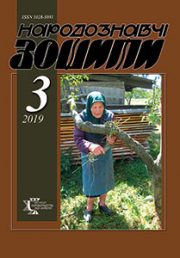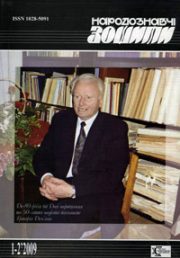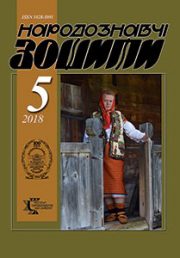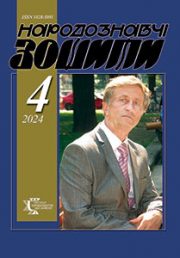The Ethnology Notebooks. 2023. № 6 (174), 1459—1468
UDK 398.831:355.4.01(470:477)”2014/…”
DOI https://doi.org/10.15407/nz2023.06.1459
LULLABY SONGS IN THE CONDITIONS OF THE RUSSIAN-UKRAINIAN WAR (since 2014): FEATURES OF FUNCTIONING
KHARCHYSHYN Olga
- ORCID ID: https://orcid.org/0000-0002-9379-8300
- Candidate of Philological Sciences
- Senior Researcher at the Ethnology Institute
- of the National Academy of Sciences of Ukraine,
- 15, Svobody Avenue, 79000, Lviv, Ukraine,
- Contacts: е-mail: okharchyshyn@gmail.com
Abstract. In the modern musical content, there are many songs with the names «ullabies» and with traditional features of the wheel genre: characteristic beginnings-formulas «Oi lyuli-lyuli», appeals «sleep, baby», «sleep, my son». Researchers paid attention to lullabies primarily as a genre of folklore for children. Until now, the ability of these songs to function as works of ethnoculture to reveal Ukrainian identity and collective defensive suggestion remains unexplored. These abilities of Ukrainian wheelwrights became particularly mature during the war.
Researchers paid attention to lullabies primarily as a genre of folklore for children. The ability of these songs to function as works of ethnoculture for the expression of Ukrainian identity and collective defensive suggestion remains unexplored. These abilities of Ukrainian lullabies became especially visible during the war.
The object of the research is the Ukrainian song repertoire in the conditions of the Russian-Ukrainian war (since 2014), which has features of lullabies.
The subject of the study is the functionality of this layer of creativity in the context of folklore tradition and modern song culture.
The source base is Internet resources, primarily social networks «YouTube», «TikTok», «Facebook», which during the war became the main medium for the spread of innovation and a place for its folklorization.
In the modern musical content, there are many songs with the names «lullaby» and with traditional features of the lullaby genre: characteristic beginnings-formulas «Oi lullaby-lullaby», appeals «sleep, baby», «sleep, my son». The functioning of these songs has much wider boundaries than traditional lullabies. Modern lullabies often contain a heroic and patriotic meaning — and in this their origins go back to the folklore and literary tradition of past centuries. Currently, the ethno-identifying and talismanic functions of lullabies against the background of military markers clearly dominate.
Popularization of lullabies is taking place in the context of the strategy of patriotic education of the future generation of Ukrainians. Interesting configurations of connections between modern «lullabies» and other forms of ethnoculture (prayers-prayers, funeral lullabies, lullabies-spells for the enemy) are outlined — and these changes are in an active phase of development.
Keywords: lullabies, functioning, function, ethnoculture, modern song culture, folklore-literary interaction, Russian-Ukrainian war.
Received 13.11.2023
REFERENCES
- Hnatiuk, V. (1916). War and folk poetry. Calendar for Sich marksmen and Ukrainian soldiers. 1917 (Pp. 68—84). Vienna [in Ukrainian].
- Dovzhenok, H. & Luhanska, K. (1984). Ukrainian folk lullabies and pastimes. Children’s folklore. Lullabies and toys. Kyiv: Naukova dumka [in Ukrainian].
- Marchun, O. (2005). Poetics of the Ukrainian folk lullaby: motives, functions, images: thesis…cand. philol. Sciences: 10.01.07. Kyiv National University named after Taras Shevchenko. Kyiv [in Ukrainian].
- Omelchenko, L. & Selivanova, V. (2008). Folklore as a symbolic interaction of communicators. Bulletin of Sumy State University. Philology series, 1, 72—76. Retrieved from: https://core.ac.uk/download/pdf/14041268.pdf (access date: 10.11.2023) [in Ukrainian].
- Hryshchenko, I. (2013). Folklorization of modern interethnic communication. Materials for Ukrainian ethnology, 12, 108—112. Retrieved from: http://www.irbis-nbuv.gov.ua/cgi-bin/irbis_nbuv/cgiirbis_64.exe?I21DBN=LINK&P21DBN=UJRN&Z21ID=&S21REF=10&S21CNR=20&S21STN=1&S21FMT=ASP_meta&C21COM=S&2_S21P03=FILA=&2_S21STR =mdue_2013_12_23 ( application date: 11.10.2023) [in Ukrainian].
- Day, O. (Ed.). (1974). Ukrainian folk songs in the records of Zorian Dolenga-Khodakovsky (from Halychyna, Volyn, Podillia, Pridnepryanshchyna and Polissia). Kyiv: Naukova dumka [in Ukrainian].
- Maksymovych, M. (Ed.). (1849). A collection of Ukrainian songs published by Mykhailo Maksymovych (Part 1). Kyiv [in Russian].
- L-kiy, N. (Ed.). (1887). Folk lullabies. Kharkiv calendar for 1888. Kharkiv collection (Issue 2, pp. 189—197) [in Ukrainian].
- Shevchenko, T. (1989). Poetry (1837—1847). A complete collection of works: in 12 vol. (Vol. 1). Kyiv: Naukova dumka [in Ukrainian].
- Shevchenko, T. (1991). Poetry (1847—1861). A complete collection of works: in 12 vol. (Vol. 2). Kyiv: Naukova dumka [in Ukrainian].
- Rudansky, S. (1972). Works: in 3 vol. (Vol. 1). Kyiv: Naukova dumka [in Ukrainian].
- Kulish, P. Lyuli-lyuli. Retrieved from: https://virshi.com.ua/pantelejmon-kulish-lyuli-lyuli/ (date of application: 11.10.2023) [in Ukrainian].
- Cherkasenko, S., & Babishkin, O. (Ed.). (1990). Lullaby of death. Poetry. Kyiv: Rad. writer [in Ukrainian].
- (1978). Record from the album «Zoryana». Vinyl 33. Yevshan Records. Canada. YouTube. Retrieved from: https://www.youtube.com/watch?v=kihlOGdSkcI&list=RDGMEMQ1dJ7wXfLlqCjwV0xfSNbA&start_radio=1&rv=jzukyHmxDQU (access date: 11.10.2023) [in Ukrainian].
- Oh moon, moon. Lyrics. Retrieved from: https://www.pisni.org.ua/songs/731868.html (access date: 11.10.2023) [in Ukrainian].
- Video presentation of the album «In the arms of lullabies». Ivanka Chervinska. Video description. YouTube. Retrieved from: https://www.youtube.com/watch?v=9v0b5ENFjUk (access date: 11.10.2023) [in Ukrainian].
- Natalya Mai. Lullaby to Ukraine. YouTube. Retrieved from: https://www.youtube.com/watch?v=fS_PQuLsTLo (access date: 11.10.2023) [in Ukrainian].
- Lullaby-charm for the children of Ukraine. YouTube. Retrieved from: https://www.youtube.com/watch?v=3_5THoe7Ous (access date: 11.10.2023) [in Ukrainian].
- Olesya Chaika. The last lullaby. YouTube. Retrieved from: https://www.youtube.com/watch?v=qPTF_89uO-U (access date: 11.10.2023) [in Ukrainian].
- Last lullaby for Artem Dymyd/Mother singing lullaby to her son for the very last time. YouTube. Retrieved from: https://www.youtube.com/watch?v=dT1tugl0bFU (access date: 11.10.2023) [in Ukrainian].
- Stasik. A lullaby for the enemy. YouTube. Retrieved from: https://www.youtube.com/watch?v=40WD9RDAMVc (access date: 11.10.2023) [in Ukrainian].
- A lullaby for an orc. Bodies, bodies, bom (in Ukrainian). YouTube. Retrieved from: https://www.youtube.com/watch?v=CLc1tT5jLaA (access date: 11.10.2023) [in Ukrainian].
- Kolyskova from ZSU. YouTube. Retrieved from: https://www.youtube.com/watch?v=KPxZbu27EMs (access date: 11.10.2023) [in Ukrainian].
- Oh the moon | Oj Misjatsju | O Dear Moon | Music Video. YouTube. Retrieved from: https://www.youtube.com/watch?v=9pJ08NOSH7E (access date: 11.10.2023) [in Ukrainian].







